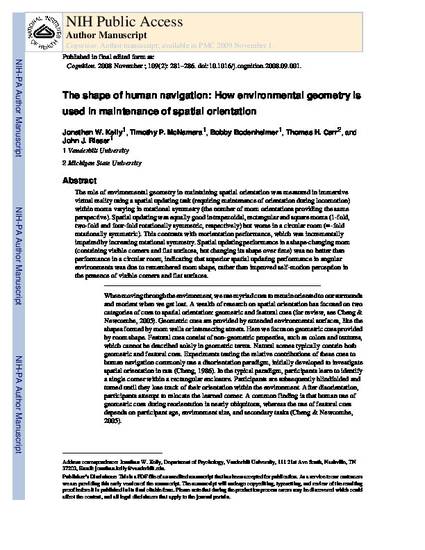
Article
The shape of human navigation: How environmental geometry is used in maintenance of spatial orientation
Cognition
(2008)
Abstract
The role of environmental geometry in maintaining spatial orientation was measured in immersive virtual reality using a spatial updating task (requiring maintenance of orientation during locomotion) within rooms varying in rotational symmetry (the number of room orientations providing the same perspective). Spatial updating was equally good in trapezoidal, rectangular and square rooms (1-fold, two-fold and four-fold rotationally symmetric, respectively) but worse in a circular room (∞-fold rotationally symmetric). This contrasts with reorientation performance, which was incrementally impaired by increasing rotational symmetry. Spatial updating performance in a shape-changing room (containing visible corners and flat surfaces, but changing its shape over time) was no better than performance in a circular room, indicating that superior spatial updating performance in angular environments was due to remembered room shape, rather than improved self-motion perception in the presence of visible corners and flat surfaces.
Disciplines
Publication Date
2008
DOI
10.1016/j.cognition.2008.09.001
Publisher Statement
This is a manuscript of an article published as Kelly, J.W., McNamara, T.P., Bodenheimer, B., Carr, T.H. & Rieser, J.J. (2008). The shape of human navigation: How environmental geometry is used in maintenance of spatial orientation . Cognition, 109, 281-286. doi: 10.1016/j.cognition.2008.09.001. Posted with permission.
Citation Information
Jonathan W. Kelly, Timothy P. McNamara, Bobby Bodenheimer, Thomas H. Carr, et al.. "The shape of human navigation: How environmental geometry is used in maintenance of spatial orientation" Cognition Vol. 109 Iss. 2 (2008) p. 281 - 286 Available at: http://works.bepress.com/jonathan_kelly/27/
